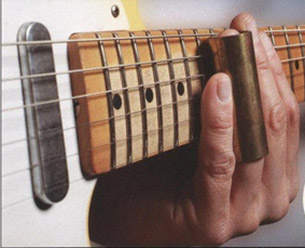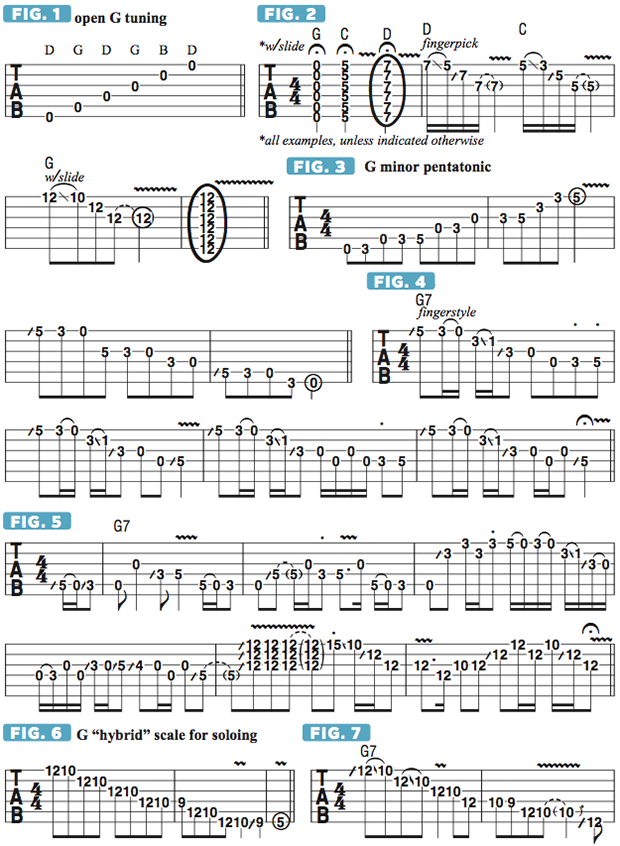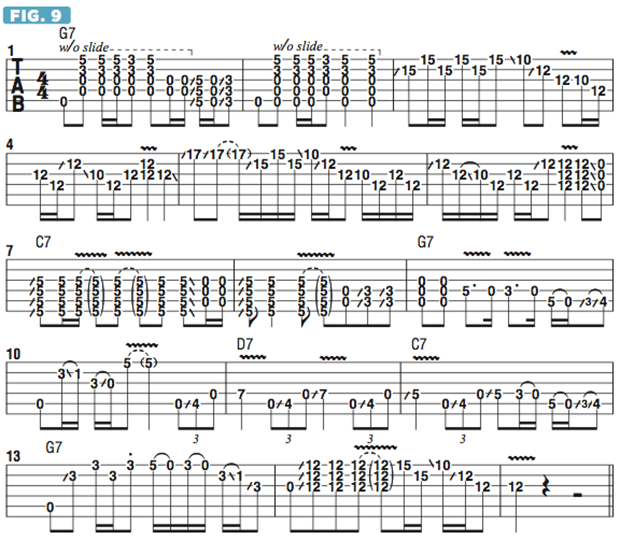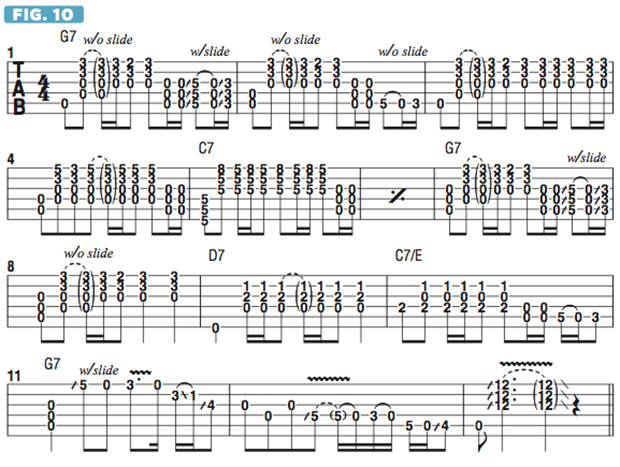Unlocking the Mysteries of Slide Guitar in Open G Tuning

Open tunings have been exploited for use with slide guitar since the earliest days of Delta blues.
The most commonly used open tunings for slide are E, D, G and A. There are, of course, others that are utilized, with many distinctive variations, depending on the musician and style of music.
Joni Mitchell has employed a wide variety of unusual tunings in her songs, as have Stephen Stills and Ry Cooder and many other contemporary musicians operating primarily in styles of music outside of blues, such as pop, rock and folk.
This edition of In Deep will focus on open G tuning and how it is used in blues slide-guitar playing.
As illustrated in FIGURE 1, open G tuning, also known as “Spanish tuning,” is spelled (low to high) D G D G B D. To tune to open G from standard tuning (E A D G B E), tune the sixth, fifth and first strings down one whole step. In this tuning, strumming across all of the open strings will sound a G major chord, with the G root note being on the fifth and third strings. Legendary Delta blues guitarist Robert Johnson used open G tuning for many of his greatest songs, such as “Crossroad Blues,” “Walkin’ Blues,” and “Come On in My Kitchen,” among others.
Just as strumming across all of the open strings yields a major chord, laying a fretting finger or a slide across all six strings at a given fret will yield a major chord based on a different, higher root note, which is likewise found on the fifth and third strings. As shown in FIGURE 2, the I, IV and V (one, four and five) chords in the key of G—G, C and D, respectively—can be sounded by using the open strings to sound G, fretting at the fifth fret to sound C and fretting at the seventh fret to sound D. In bar 2, I demonstrate some standard open G-style slide licks over D and C, followed in bars 3 and 4 with slide licks in G and the G major chord sounded by at the 12th fret.
Now let’s look at some standard scale positions in open G that are commonly used for soloing, either with or without the slide. As shown in FIGURE 3, the G minor pentatonic scale (G Bb C D F) can be sounded by using a nearly symmetrical fretboard pattern, or “shape,” across all the strings except the second. In this example, I ascend the scale in one pattern and descend in a slightly different one. Practice and memorize both patterns, with and without a slide. When playing with a slide, be sure to keep it parallel to the fretwire and positioned directed over it in order to sound properly in tune.
All the latest guitar news, interviews, lessons, reviews, deals and more, direct to your inbox!
In FIGURE 4, I run through a few solo-type phrases that employ G minor pentatonic played in this pattern. Like many guitarists, I prefer to fingerpick when playing slide, as this facilitates the use of pick-hand muting, or damping, techniques, which are used to suppress string vibration and sounds on strings you no longer want to ring. For example, when moving from one string to another, I’ll often stop the previously played string from ringing by touching it with one of my pick-hand fingers before picking the next note. This way, each note rings clearly without any others ringing, or “bleeding,” into it, which can create a muddy sound, especially if you’re playing with an overdriven tone.
The great Johnny Winter is a true master of slide guitar in open G tuning (as well as other tunings). Johnny used the similarly structured open A tuning (open G up one whole step: low to high, E A E A C# E) to perform his masterpiece “Dallas,” recorded for his 1969 self-titled album. FIGURE 5 offers a seven-bar solo played in Winter’s style. Notice the ongoing use of open strings throughout, which serve to facilitate moving from one string and position to the next while keeping the solo sounding rich and full. At the end of the phrase, I jump up to 12th position and lay the slide across the top three strings at the 12th fret to sound a G major triad, followed by licks that move between the 10th and 12th frets.
FIGURE 6 illustrates a useful G “hybrid” scale for slide soloing in open G tuning wherein notes are played at the 10th and 12th frets of each string along with the inclusion of the ninth fret of the fourth and sixth strings. As demonstrated in FIGURE 7, practice sliding down from the 12th to the 10th fret on each string, as well as sliding up to each note. Additional higher notes can be added to this scale pattern by sliding up to the 15th and 17th frets (see FIGURE 8). Again, practice sliding into and out of each position with careful attention to achieving good intonation (pitch centering).
Let’s wrap up with two examples of how to navigate through two full choruses of a 12-bar blues in G. In FIGURE 9, a G7 chord is sounded without the slide by barring the fret-hand index finger across the top two strings at the third fret while sounding the open third and fourth strings simultaneously. In bars 1–3, I alternate between conventional fretting and sounding notes with the slide. In bars 11 and 12, I outline the V and IV chords, D7, and C7, Muddy Waters–style, by playing a single-note melody that simply outlines the aforementioned chords.
FIGURE 10 is in the style of “Dallas.” The opening chordal figure, played in bars 1–3, 6 and 7, is performed without the slide and moves alternately from G7 to G6, with the sixth sounded by dropping down to the first string’s second fret. In bar 5, C7 is fretted conventionally, and in bars 9 and 10, D7 and C7 are sounded with useful first-position voicings, after which I return to the I chord, G7, and play some free-style licks utilizing the open strings.




Guitar World Associate Editor Andy Aledort is recognized worldwide for his vast contributions to guitar instruction, via his many best-selling instructional DVDs, transcription books and online lessons. Andy is a regular contributor to Guitar World and Truefire, and has toured with Dickey Betts of the Allman Brothers, as well as participating in several Jimi Hendrix Tribute Tours.

